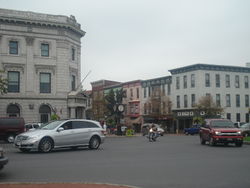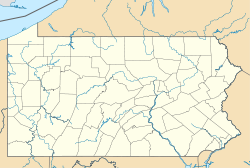Gettysburg, Pennsylvania
| Gettysburg, Pennsylvania | |
|---|---|
| — Borough — | |
 |
|
 |
|
| Coordinates: | |
| Country | United States |
| State | Pennsylvania |
| County | Adams |
| Settled | 1780 |
| Incorporated | 1806 |
| Government | |
| - Type | Borough Council |
| - Mayor | William Troxell |
| Area | |
| - Total | 4.3 sq mi (11.1 km2) |
| - Land | 4.2 sq mi (10.9 km2) |
| - Water | 0.1 sq mi (0.3 km2) |
| Elevation | 558 ft (170 m) |
| Population (2000) | |
| - Total | 7,490 |
| - Density | 4,562.3/sq mi (1,761.5/km2) |
| Time zone | Eastern (EST) (UTC-5) |
| - Summer (DST) | EDT (UTC-4) |
| Zip code | 17325 |
| Area code(s) | 717 |
| Website | Borough of Gettysburg |
Gettysburg (locally /ˈɡɛtɨsbɜrɡ/ (![]() listen), with an ss sound) is a borough in and the county seat of Adams County, Pennsylvania, United States.[1] The population was 7,490 at the 2000 census.
listen), with an ss sound) is a borough in and the county seat of Adams County, Pennsylvania, United States.[1] The population was 7,490 at the 2000 census.
Although known primarily as an attraction because of its proximity to the Gettysburg Battlefield, site of the Battle of Gettysburg, the borough is also known for its institutions of higher learning, namely the Lutheran Theological Seminary, founded in 1826, Gettysburg College (originally Pennsylvania College), which began operating in 1832, and Harrisburg Area Community College.
Many roads radiate from Gettysburg, providing hub-like access to Washington, D.C. 75 miles (121 km), Baltimore 55 miles (89 km), Harrisburg 37 miles (60 km), Carlisle 27 miles (43 km), Frederick and Hagerstown, Maryland 32 miles (51 km) and Hanover, Pennsylvania 14 miles (23 km). Chambersburg is 25 miles (40 km) west on the Lincoln Highway (U.S. Route 30), the first transcontinental U.S. highway. Today the borough is a 2½ hour drive from Philadelphia and a 3½ hour drive from Pittsburgh via the Pennsylvania Turnpike and U.S. Route 15. Gettysburg Regional Airport, a small general aviation airport, is located 2 miles (3.2 km) west of Gettysburg.
In June 2009, the Adams County Transit Authority implemented local transportation service to the borough operating under the name Freedom Transit[2]
Contents |
Climate
Gettysburg has seasonal weather that varies from around 20 ℉ (−6.7 ℃) in the winter months to almost 100 ℉ (37.8 ℃) in the summer.
History and culture
The town had it's start as a tavern owned by Samuel Gettys, a settler and early start businessman, who built the tavern between 1774 and 1775 where soldiers and traders came to rest often as it sat on the Shippensburg - Baltimore and Philadelphia - Pittsburgh cross roads. The town of Gettysburg wasn't founded until 1786 where it was named after Gettys' himself.[3]
In 1858 the Gettysburg Railroad completed construction of a railroad line from Gettysburg to Hanover. The Gettysburg Railroad Station opened in 1859. Passenger train service to the city ended in 1942. The station was restored in 2006 and currently operates as a museum.
Gettysburg, home to the Battle of Gettysburg (1863) of the American Civil War, draws in large numbers of tourists every year to visit the historical sites around the small community as well as the battlefield itself. Gettysburg has many activities and tours to offer to vacationers and tourists that are interested in the Gettysburg area and the history of the community and the battle. A narrated tour via double-decker bus and tours of the Jenny Wade house are two examples. Ghost tours are also popular with tourists, profiling various locations reported to be haunted. One of the most popular times to visit Gettysburg is in the Summer and early Fall months, about June through October.
A popular attraction in Gettysburg is the reenactment of the Battle of Gettysburg which is held every summer for the three days around the Fourth of July. Events include tours, ghost stories and reenactments.
The Dobbin House Tavern, which is one of the most famous restaurants in Gettysburg, was once home to Reverend Alexander Dobbin in 1776. The restaurant has since been authentically restored and provides an ambiance that was once present during the historic days of Gettysburg. The Dobbin House is lit by candles while the wait staff serves authentic foods from two centuries ago dressed in Civil War attire. Other historical attractions are the hotels and bed and breakfasts around the borough. The Gettysburg Hotel is a popular destination for tourists because of all the history that the hotel holds. The Gettysburg Hotel is located in the heart of downtown Gettysburg, within walking distance to historical sites, restaurants and shopping. The hotel has been in business since 1797 and in 1863 witnessed events that took place during the three day battle.
Demographics
As of the census[4] of 2000, there were 7,490 people, 2,541 households, and 1,229 families residing in the borough. The population density was 4,562.3 inhabitants per square mile (1,761.5 /km2). There were 2,759 housing units at an average density of 1,680.6 per square mile (648.9 /km2). The racial makeup of the borough was 85.46% White, 5.79% Black or African American, 0.37% Native American, 1.28% Asian, 0.04% Pacific Islander, 4.67% from other races, and 2.38% from two or more races. 8.02% of the population were Hispanic or Latino of any race.
There were 2,541 households out of which 22.5% had children under the age of 18 living with them, 32.6% were married couples living together, 12.6% had a female householder with no husband present, and 51.6% were non-families. 42.5% of all households were made up of individuals and 16.7% had someone living alone who was 65 years of age or older. The average household size was 2.17 and the average family size was 2.94.
In the borough the population was spread out with 16.2% under the age of 18, 36.2% from 18 to 24, 19.1% from 25 to 44, 15.9% from 45 to 64, and 12.5% who were 65 years of age or older. The median age was 23 years. For every 100 females there were 88.1 males. For every 100 females age 18 and over, there were 85.1 males.
The median income for a household in the borough was $29,840, and the median income for a family was $40,489. Males had a median income of $30,341 versus $21,111 for females. The per capita income for the borough was $14,157. About 13.2% of families and 19.4% of the population were below the poverty line, including 24.0% of those under age 17 and 5.2% of those age 77 or over.
Tourism information
The main industry of the borough is tourism. Many places of interest involving the Battle of Gettysburg include Little Round Top, the High-water mark of the Confederacy on Cemetery Ridge, the Gettysburg Cyclorama, Devil's Den, and the Peacelight Memorial. Each summer around the days of July 1–3 (usually the first weekend of the month) visitors can witness the reenactment of the 1863 battle. Another site maintained by the National Park Service, the Eisenhower Farm, is also a popular tourist destination.
Media
- Adams Community TV ACTV, a non-profit media company.
- The Gettysburg Times, a daily newspaper.
- Raices De Todos, a bilingual monthly cultural magazine, serves the city's growing Latino/Hispanic population.
- The Evening Sun, a daily newspaper.
- "Celebrate Gettysburg," a lifestyles magazine dedicated to life in and around Gettysburg
- Gettysburg Daily a daily independent news outlet.
Colleges and universities
- Gettysburg College
- Harrisburg Area Community College (Gettysburg Campus)
- Lutheran Theological Seminary at Gettysburg
Sister cities
Gettysburg has one sister city, as designated by Sister Cities International.
 León, Nicaragua (1987)
León, Nicaragua (1987)
See also
- Gettysburg, Ohio
References
- ↑ "Find a County". National Association of Counties. http://www.naco.org/Template.cfm?Section=Find_a_County&Template=/cffiles/counties/usamap.cfm. Retrieved 2008-01-31.
- ↑ http://www.eveningsun.com/ci_12715035?source=most_emailed
- ↑ gettysburg-pa.gov
- ↑ "American FactFinder". United States Census Bureau. http://factfinder.census.gov. Retrieved 2008-01-31.
Bibliography
- The History and Topography of Dauphin, Cumberland, Franklin, Bedford, Adams, and Perry Counties Lancaster City, PA: Gilbert Hills, 1846.
External links
- Gettysburg travel guide from Wikitravel
- Gettysburg Convention & Visitors Bureau
- Borough of Gettysburg
- Gettysburg Times
|
|||||||||||||||||||||||
|
|||||||||||
